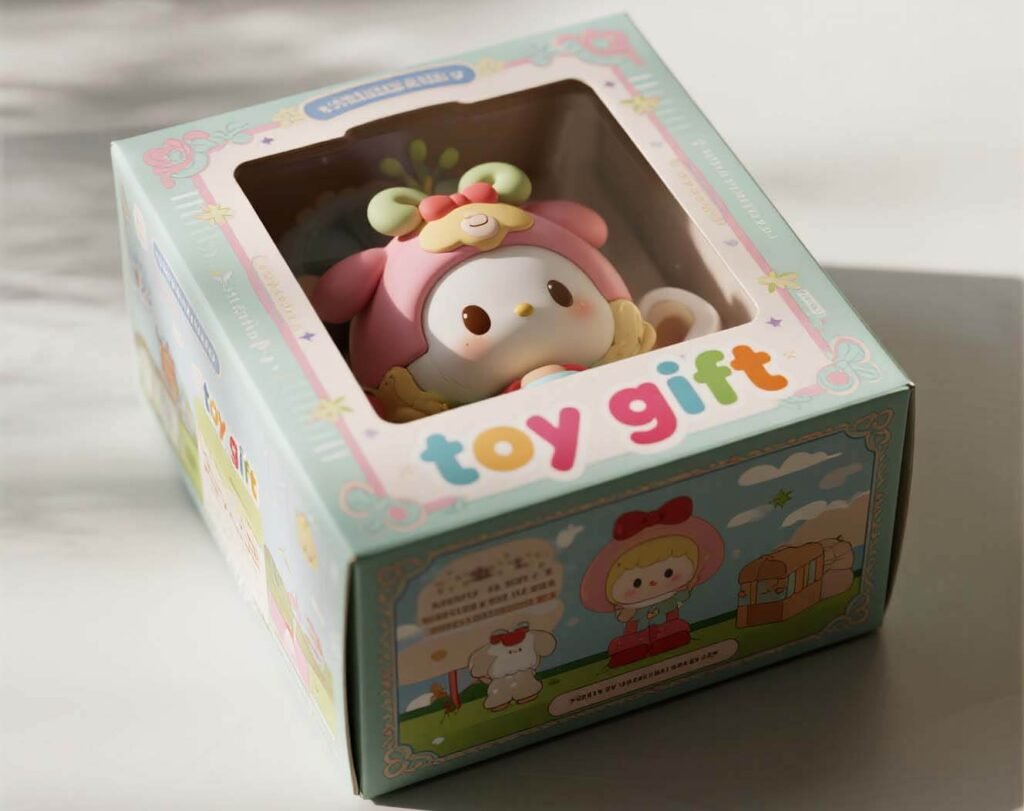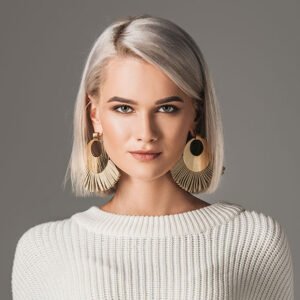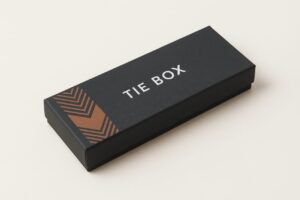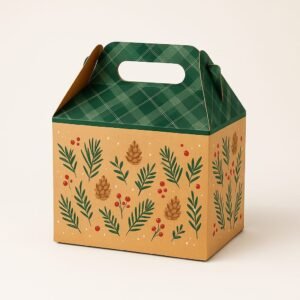Ever picked up a product simply because you could see it through a little clear panel on the front? That’s the magic of window box packaging. It’s a paperboard or cardboard box with a transparent “window” (often PET plastic or a biodegradable film) that lets shoppers preview what’s inside—color, texture, shape—without opening the package. The result: faster trust,fewer returns, and a shelf presence that catches eyes from a distance.
In this guide, we’ll break down how window boxes work, the materials involved, where they
shine across industries, and how to design one that’s good-looking and easy to recycle.
We’ll also weave in practical tips, a quick buyer’s checklist, and a friendly, no-pressure call to action at the end in case you want help planning your first run.
The Simple Idea Behind Window Packaging

At its core, a window box is a duo-carton (paperboard + clear film). The paper structure
gives strength and printable real estate for branding, while the window shows off the product—think macarons, candles, cosmetics, stationery, small electronics, toys, or apparel accessories. Brands lean on them because people trust what they can see; the window removes guesswork and nudges a decision.
You’ll see this format described a few ways online—window gift boxes, gift box with window, boxes with windows packaging, packaging boxes with window, custom window box packaging, window gift boxes wholesale—but all point back to the same idea: a printed paper box with a showcase panel.
Common Materials and What to Know About Them
Most window box packaging relies on a paper-based body plus a clear film:
Paperboard body
- SBS (Solid Bleached Sulfate): Smooth, white, premium look for cosmetic or
confectionery boxes. Take print and foil well. - Kraft (unbleached): Natural, eco-forward vibe. Great for earthy brands.
- Corrugated (micro-flute): When you need a bit more strength for heavier goods.
Window films
- PET (#1): Clear, tough, and widely recycled relative to other plastics. A better
sustainability pick than PVC in most markets. - PVC (#3): Clear and inexpensive but less recyclable and increasingly discouraged by
many brands. - Bioplastics (e.g., PLA) or cellulose films: Compostable/biodegradable options exist;
availability and end-of-life pathways vary by region.
Quick Comparison Table
| Component | Typical Options | Why Choose It | Notes |
|---|---|---|---|
| Box board | SBS, Kraft, micro-flute corrugated | Print quality or strength | Consider FSC-certified boards to support responsible forestry. |
| Window | PET | Clarity, impact resistance, better recyclability than PVC | Often labeled #1; infrastructure is common. |
| Window | PVC | Low cost | Recycling is limited; many brands are phasing it out. |
| Window | PLA/cellulose films | Bio-based story | Check real end-of-life options in your market. |
Tip: If sustainability is central to your brand, combine FSC-certified paperboard with PET (or windowless cutouts) and clear disposal guidance on-pack. Consumers recognize the FSC logo and increasingly look for it.
How the “window” Gets There and Why Shape Matters
Manufacturers use die cutting: a custom metal die stamps the opening in the board; the clear film is glued behind it; then the box is folded and glued.Because dies can be shaped, you’re not limited to rectangles—circles, arches, product silhouettes, or even multi-window designs are common. Clever die cuts add personality while staying functional.
Die-cutting also helps with fit and protection—inner trays, inserts, or “cradles” can be added to keep products aligned exactly behind the window. That precision reduces shake, scuffs, and returns.
Benefits You’ll Notice on Day One
1. Instant product preview. A cardboard box with a window (or Cardboard Box with
Window Lid) lets shoppers judge colorways, finishes, and sizes at a glance—exactly
what matters for cosmetics, candles, pastries, textiles, and tech accessories.
2. Higher perceived transparency. You’re literally showing what’s inside—consumers
often equate visibility with honesty.
3. Branding + storytelling. Use printing, foil, embossing, and smart window shapes to
make the box feel “giftable” without extra wrapping—think window gift boxes for
holidays or launches.
4. Fewer returns for color/finish issues. Seeing the actual item reduces surprises.
5. Shelf standout. A gift box with a window creates a small stage for the product—perfect for crowded retail.
But What About Recycling?
Great question. The paper part is usually recyclable where paper recycling exists. The clear
window can complicate things, so design matters:
- Paper + small plastic windows:In many paper mills, small plastic windows are screened out during pulping, meaning consumers don’t have to remove the window for the paper to be recycled—though local guidance still applies.
- Designing for recyclability:The How2Recycle program provides standardized on-pack labels and specific design guidance. For “optimal recyclability,” they advise limiting non-paper components like large plastic windows or using easily removable windows.
- Material choice:PET windows are generally a better bet than PVC if you must use plastic.
Practical move: Ask your converter to spec FSC-certified board + PET window and to follow
How2Recycle guidance for label claims. It’s a small tweak with a big trust payoff.
Where Window Boxes Shine (with examples)
| Industry / Use | Why It Fits | Typical Details |
|---|---|---|
| Confectionery & bakery | Visuals sell—macarons, cupcakes, truffles look irresistible in a window box packaging format. | SBS board, PET window, food-safe inks/varnishes. |
| Cosmetics & beauty | Shade-matching matters; let shoppers see tones and textures. | Foil + emboss elements, shaped window. |
| Toys & hobbies | Parents want to confirm size and parts count at a glance. | Corrugated micro-flute for strength; inner tray. |
| Home fragrance | Candle wax colors and vessel designs do the talking. | Kraft looks for natural lines; cutout or film. |
| Stationery & gifts | Ready-to-gift presentation with the “peekaboo” effect. | Custom window box packaging for sets, ribbons, and inserts. |
If you’re sourcing at scale, you’ll see window gift boxes wholesale listings—handy for event
kits and seasonal drops where budget and speed matter.
Design Tips that Keep Customers and the Planet Happy
1. Right-size the window. Give just enough views to build trust without weakening the box. Overly large cutouts can reduce rigidity unless you add a thicker board or keep a paper “frame.”
2. Mind the glue area. Your converter needs a clean flange to bond the film; avoid artwork or creases in that zone.
3. Use inserts. Trays or die-cut cradles keep products centered and “photo-ready” behind the window, especially important for packaging boxes with windows on shelves.
4. Choose PET over PVC. It’s clearer, more robust, and commonly recycled compared
to PVC. If your brand story is eco-first, consider a windowless die-cut (no film) or a certified compostable film—just verify end-of-life pathways.
5. Add trusted marks. FSC on paperboard and a How2Recycle label help consumers dispose correctly and see your commitment.
When a Cardboard Box with Window Beats a Plain Carton

- Premium gifting: The unboxing moment begins on the shelf when the product is
already on display. - Color-critical items: Cosmetics, yarn, candles, and paints benefit from visible hue
verification. - Texture-first goods: Bath bombs, artisanal soaps, and textiles sell on feel and
look—visibility helps. - Impulse channels: At checkout or endcaps, window packaging boxes can clinch the
add-on sale.
Cost, MOQ, and Print Options (What to Expect)
- Tooling: Custom dies are a one-time cost (kept on file for reorders). If the budget is
tight, ask for standard die sizes. - Minimum orders: Vary by supplier; “window gift boxes wholesale” sources can
reduce per-unit price when you order by the thousand. - Printing: Offset for premium runs; digital for short runs or seasonal variants. Special
finishes—soft touch, spot UV, metallic foil—add perceived value. - Lead times: Account for die creation, print, window application, and finishing.
(Reorders are faster if you reuse the die.)
A Lightweight Buyer’s Checklist
Use this when you brief a converter for custom window box packaging or window box
packaging design:
- Product dimensions & weight (plus any inserts needed)
- Board type (SBS or kraft; consider FSC-certified)
- Window size/shape (and whether you prefer PET or a film-free cutout)
- Print spec (CMYK, spot colors, coatings, embellishments)
- Sustainability (FSC logo use, How2Recycle label language)
- Shipping/storage (flat-packed or pre-glued; pallet quantity)
- Compliance (food contact inks/varnishes if needed)
A Tiny Table to Match Box Types to Goals
| Industry / Use | Why It Fits | Typical Details |
|---|---|---|
| Confectionery & bakery | Visuals sell—macarons, cupcakes, truffles look irresistible in a window box packaging format. | SBS board, PET window, food-safe inks/varnishes. |
| Cosmetics & beauty | Shade-matching matters; let shoppers see tones and textures. | Foil + emboss elements, shaped window. |
| Toys & hobbies | Parents want to confirm size and parts count at a glance. | Corrugated micro-flute for strength; inner tray. |
| Home fragrance | Candle wax colors and vessel designs do the talking. | Kraft looks for natural lines; cutout or film. |
| Stationery & gifts | Ready-to-gift presentation with the “peekaboo” effect. | Custom window box packaging for sets, ribbons, and inserts. |
Tip: If sustainability is central to your brand, combine FSC-certified paperboard with PET (or windowless cutouts) and clear disposal guidance on-pack. Consumers recognize the FSC
logo and increasingly look for it.
How the “window” Gets There and Why Shape Matters
Manufacturers use die cutting: a custom metal die stamps the opening in the board; the clear film is glued behind it; then the box is folded and glued. Because dies can be shaped, you’re not limited to rectangles—circles, arches, product silhouettes, or even multi-window designs are common. Clever die cuts add personality while staying functional.
Die-cutting also helps with fit and protection—inner trays, inserts, or “cradles” can be added to keep products aligned exactly behind the window. That precision reduces shake, scuffs, and returns.
Benefits You’ll Notice on Day One
1. Instant product preview. A cardboard box with a window (or Cardboard Box with Window Lid) lets shoppers judge colorways, finishes, and sizes at a glance—exactly what matters for cosmetics, candles, pastries, textiles, and tech accessories.
2. Higher perceived transparency. You’re literally showing what’s inside—consumers often equate visibility with honesty.
3. Branding + storytelling. Use printing, foil, embossing, and smart window shapes to make the box feel “giftable” without extra wrapping—think window gift boxes for holidays or launches.
4. Fewer returns for color/finish issues. Seeing the actual item reduces surprises.
5. Shelf standout. A gift box with a window creates a small stage for the product—perfect for crowded retail.
But What About Recycling?
Great question. The paper part is usually recyclable where paper recycling exists. The clear
window can complicate things, so design matters:
- Paper + small plastic windows:In many paper mills, small plastic windows are screened out during pulping, meaning consumers don’t have to remove the window for the paper to be recycled—though local guidance still applies.
- Designing for recyclability:The How2Recycle program provides standardized on-pack labels and specific design guidance. For “optimal recyclability,” they advise limiting non-paper components like large plastic windows or using easily removable windows.
- Material choice:PET windows are generally a better bet than PVC if you must use plastic.
Practical move: Ask your converter to spec FSC-certified board + PET window and to follow How2Recycle guidance for label claims. It’s a small tweak with a big trust payoff.
Where Window Boxes Shine (with examples)
| Industry / Use | Why It Fits | Typical Details |
|---|---|---|
| Confectionery & bakery | Visuals sell—macarons, cupcakes, truffles look irresistible in a window box packaging format. | SBS board, PET window, food-safe inks/varnishes. |
| Cosmetics & beauty | Shade-matching matters; let shoppers see tones and textures. | Foil + emboss elements, shaped window. |
| Toys & hobbies | Parents want to confirm size and parts count at a glance. | Corrugated micro-flute for strength; inner tray. |
| Home fragrance | Candle wax colors and vessel designs do the talking. | Kraft looks for natural lines; cutout or film. |
| Stationery & gifts | Ready-to-gift presentation with the “peekaboo” effect. | Custom window box packaging for sets, ribbons, and inserts. |
If you’re sourcing at scale, you’ll see window gift boxes wholesale listings—handy for event
kits and seasonal drops where budget and speed matter.
Design Tips that Keep Customers and the Planet Happy
1. Right-size the window. Give just enough views to build trust without weakening the box. Overly large cutouts can reduce rigidity unless you add a thicker board or keep a paper “frame.”
2. Mind the glue area. Your converter needs a clean flange to bond the film; avoid artwork or creases in that zone.
3. Use inserts. Trays or die-cut cradles keep products centered and “photo-ready” behind the window, especially important for packaging boxes with windows on shelves.
4. Choose PET over PVC. It’s clearer, more robust, and commonly recycled compared
to PVC. If your brand story is eco-first, consider a windowless die-cut (no film) or a certified compostable film—just verify end-of-life pathways.
5. Add trusted marks. FSC on paperboard and a How2Recycle label help consumers
dispose correctly and see your commitment.
When a Cardboard Box with Window Beats a Plain Carton
- Premium gifting: The unboxing moment begins on the shelf when the product is
already on display. - Color-critical items: Cosmetics, yarn, candles, and paints benefit from visible hue
verification. - Texture-first goods: Bath bombs, artisanal soaps, and textiles sell on feel and
look—visibility helps. - Impulse channels: At checkout or endcaps, window packaging boxes can clinch the
add-on sale.
Cost, MOQ, and Print Options (What to Expect)
- Tooling: Custom dies are a one-time cost (kept on file for reorders). If the budget is
tight, ask for standard die sizes. - Minimum orders: Vary by supplier; “window gift boxes wholesale” sources can
reduce per-unit price when you order by the thousand. - Printing: Offset for premium runs; digital for short runs or seasonal variants. Special
finishes—soft touch, spot UV, metallic foil—add perceived value. - Lead times: Account for die creation, print, window application, and finishing.
(Reorders are faster if you reuse the die.)
A Lightweight Buyer’s Checklist
Use this when you brief a converter for custom window box packaging or window box
packaging design:
- Product dimensions & weight (plus any inserts needed)
- Board type (SBS or kraft; consider FSC-certified)
- Window size/shape (and whether you prefer PET or a film-free cutout)
- Print spec (CMYK, spot colors, coatings, embellishments)
- Sustainability (FSC logo use, How2Recycle label language)
- Shipping/storage (flat-packed or pre-glued; pallet quantity)
- Compliance (food contact inks/varnishes if needed)
A Tiny Table to Match Box Types to Goals
| Industry / Use | Why It Fits | Typical Details |
|---|---|---|
| Confectionery & bakery | Visuals sell—macarons, cupcakes, truffles look irresistible in a window box packaging format. | SBS board, PET window, food-safe inks/varnishes. |
| Cosmetics & beauty | Shade-matching matters; let shoppers see tones and textures. | Foil + emboss elements, shaped window. |
| Toys & hobbies | Parents want to confirm size and parts count at a glance. | Corrugated micro-flute for strength; inner tray. |
| Home fragrance | Candle wax colors and vessel designs do the talking. | Kraft looks for natural lines; cutout or film. |
| Stationery & gifts | Ready-to-gift presentation with the “peekaboo” effect. | Custom window box packaging for sets, ribbons, and inserts. |
Bottom Line
Window box packaging blends form and function: the confidence of seeing the product, the branding canvas of a printed box, and the usability that retailers love. With thoughtful choices—FSC-certified board, PET windows, tidy die cuts, and honest on-pack recycling instructions—you can make packaging that looks beautiful on the shelf and behaves responsibly after purchase.
Ready to Design Yours?
If you’re thinking, “This would be perfect for my candles / confectionery / skincare line,”
you’re probably right. Send us your product dimensions, a photo, and a vibe (glossy luxe,
earthy kraft, playful color), and we’ll sketch out custom window box packaging options—complete with suggested materials, dieline notes, and print finishes. Let’s build a
gift box with a window that’s effortlessly shoppable and easy to recycle.


